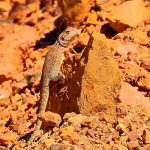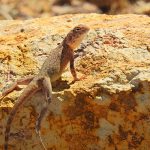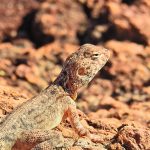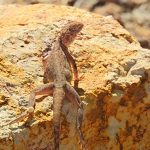SLATER'S RING-TAILED DRAGON
(Ctenophorus slateri)
Slater’s Ring-tailed Dragon is a fascinating reptile native to Australia. This dragon is primarily found in the arid and semi-arid regions of central Australia, including parts of the Northern Territory, South Australia, and Western Australia.
It thrives in rocky outcrops, spinifex grasslands, and sandy deserts, where it can bask in the abundant sunshine and find shelter among the rocks and vegetation.
Slater’s Ring-tailed Dragon is a small to medium-sized lizard, typically reaching lengths of about 20 to 25 centimetres. Its most distinguishing feature is the striking ringed pattern on its tail, which not only gives the species its common name but also serves as a form of camouflage among the rocky terrain. The dragon’s body is usually adorned with shades of brown, grey, and reddish hues, allowing it to blend seamlessly with its surroundings. Like many lizards, Slater’s Ring-tailed Dragon has the ability to shed its tail to escape predators. The tail will eventually regrow, although it may not be as perfectly formed as the original.
Slater’s Ring-tailed Dragon uses a variety of visual signals, such as head bobbing and tail waving, to communicate with other lizards. These behaviours are particularly prominent during mating season and territorial disputes.
Breeding season for Slater’s Ring-tailed Dragon generally occurs during the warmer months, from late spring to early summer. Males become particularly territorial and display vibrant colour changes to attract females and ward off rivals. After mating, the female lays a clutch of eggs, typically between 5 to 10, in a carefully chosen burrow or under a rock crevice. The incubation period lasts about two to three months, after which the tiny hatchlings emerge, fully independent and ready to face the world.
In the wild, Slater’s Ring-tailed Dragon has a lifespan of approximately 5 to 7 years, although this can vary depending on environmental conditions and predation pressures. These dragons are diurnal, meaning they are active during the day. They spend much of their time basking in the sun to regulate their body temperature, foraging for food, and keeping a watchful eye for predators such as birds of prey and larger reptiles. They are masters of thermoregulation. By changing their body position and colour, they can efficiently absorb or reflect sunlight to maintain their ideal body temperature.
Slater’s Ring-tailed Dragon is an insectivore, primarily feeding on a diet of ants, beetles, spiders, and other small invertebrates. Occasionally, it may also consume plant material, particularly in times of food scarcity. Its keen eyesight and agile movements make it an adept hunter, capable of snatching up prey with remarkable speed.
While Slater’s Ring-tailed Dragon is not currently listed as endangered, its habitat is increasingly threatened by human activities such as land clearing and mining. Conservation efforts are essential to ensure that these unique reptiles continue to thrive in their natural habitats. By preserving the arid and semi-arid landscapes they call home, we can help protect this remarkable species for future generations to appreciate.
Slater’s Ring-tailed Dragon is a captivating example of Australia’s diverse and resilient wildlife. Its unique adaptations and behaviours offer a glimpse into the intricate balance of life in some of the harshest environments on Earth. By learning about and appreciating such creatures, we can foster a deeper connection with nature and a stronger commitment to conservation.




